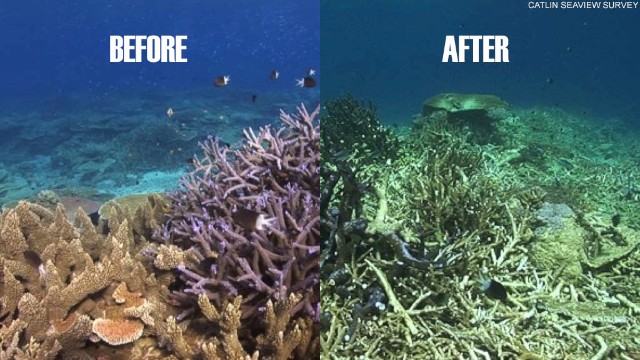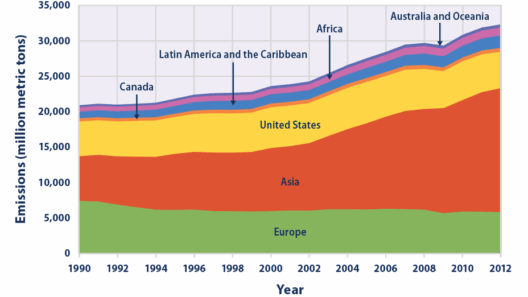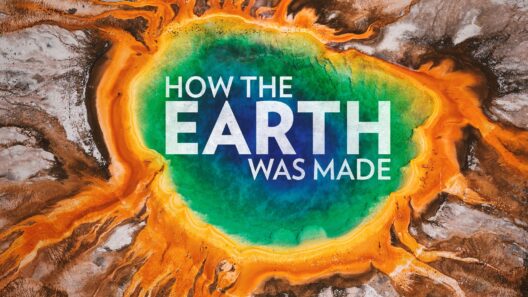Coral reefs, often dubbed the “rainforests of the sea,” captivate not only with their breathtaking beauty but also with their unparalleled biodiversity. These aquatic landscapes serve as vital ecosystems, housing approximately 25% of all marine species, despite occupying less than 1% of the ocean floor. However, this rich tableau is under implacable threat, primarily due to global warming. The phenomenon of coral bleaching, an alarming indicator of reef health, has surged in recent decades, leading to widespread death and degradation of these essential marine habitats.
Coral reefs are built by colonies of tiny organisms called coral polyps, which form symbiotic relationships with algae known as zooxanthellae. These algae are integral to coral health; they provide energy through photosynthesis and impart the vibrant colors that characterize healthy reefs. However, when water temperatures rise, corals become stressed. Under conditions of thermal stress, they expel their algal partners, resulting in the phenomenon known as coral bleaching. The stark white skeletal structures of bleached corals serve as a chilling testament to the underlying distress.
Several factors contribute to rising sea temperatures, with fossil fuel combustion being a predominant driver. The increased concentration of greenhouse gases, particularly carbon dioxide, leads to myriad climatic changes, including rising ocean temperatures. Every degree increase in sea temperature can have catastrophic effects on coral ecosystems, creating conditions conducive to bleaching events. From 1979 to 2019, it was documented that ocean temperatures have risen by an average of 0.13 degrees Celsius per decade—a seemingly modest increase with dire ramifications for coral reefs.
Beyond temperature increases, ocean acidification, another byproduct of climate change, further exacerbates the plight of these ecosystems. Increased levels of carbon dioxide in the atmosphere lead to higher concentrations of this gas in seawater, resulting in a decrease in pH. This acidic environment impairs the ability of corals to form their calcium carbonate skeletons, vital for their growth and structural integrity. Weakening coral structures increases susceptibility to disease and environmental stressors, debilitating the entire reef system. Marine biologists are becoming increasingly cognizant that the convergence of stressors—thermal, acidic, and increasingly polluted waters—places corals in a precarious position, threatening their survival and the myriad species that depend on them.
Bleaching events are not merely tragic incidents; they are symptomatic of a larger crisis. Reefs worldwide are undergoing mass bleaching, with the Great Barrier Reef experiencing three significant bleaching events in just five years. These occurrences are documented in the long-term State of the Climate reports, illustrating a disturbing trend. The implications extend well beyond aesthetic losses. Coral reefs contribute significantly to coastal protection, providing a barrier against storm surges and erosion, as well as serving as critical habitats for fish and other marine species. The economic ramifications are profound, as many coastal economies rely on tourism and fishing, both of which are intimately connected to healthy reef systems.
The urgency of the crisis has prompted a multifaceted response from scientists, activists, and policymakers. Coral restoration and resilience-building strategies are being explored. Researchers are investigating the possibility of breeding heat-resistant coral strains, fostering genetic diversity, and introducing these traits into existing populations. Other initiatives include assisted gene flow, cross-breeding resilient coral species, and employing techniques to maintain the health of existing coral ecosystems through targeted conservation efforts.
Moreover, addressing the root causes of climate change is paramount. Transitioning to renewable energy sources, curtailing greenhouse gas emissions, and advocating for sustainable practices in industries contributing to pollution are necessary steps toward mitigating the impact on coral reefs. The Paris Agreement’s goal of limiting global warming to well below 2 degrees Celsius is crucial—not only for coral reefs but for the planet’s overall ecological balance.
Community engagement plays a transformative role in the narrative of coral conservation. Grassroots movements can foster awareness and activate local stewardship initiatives. Educational campaigns can mobilize citizens to appreciate the intrinsic value of coral ecosystems and the multitude of services they provide. Understanding local biases towards conservation and engaging communities in reef restoration projects can bridge the gap between scientific endeavors and public engagement.
In conclusion, coral reefs are at a pivotal juncture. The convergence of climate change effects presents a critical challenge that requires concerted global action. The intersection of complex ecological dynamics, economic imperatives, and social responsibilities demands a nuanced understanding and a proactive approach. Without significant intervention, we risk not only losing a vital resource but also eradicating a cornerstone of marine biodiversity and the myriad life forms relying on these ecosystems for survival.
As we gaze into the depths of our oceans, the call to action echoes resoundingly. It is imperative to understand that behind the resplendent colors of coral reefs lies a narrative of survival, fragility, and resilience. Preserving these natural treasures is no longer just an environmental issue; it is a moral obligation, incumbent upon this generation to ensure that the vibrant underwater gardens of our planet endure for generations to come.








